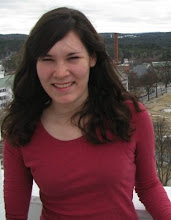









Two weeks ago, we went to the Museo de la Nacion (National Museum) for our volunteer trip. The museum is being renovated, so they only have three exhibits open right now. However, two of them were the best and most important exhibits in the museum, so I don't think I missed out on anything at all. Plus, admission was free because of the construction!
The first exhibit showed Peruvian art through the years, beginning with the very first indigenous art in the country and ending with very current pieces. I really enjoyed this exhibit because it showed so much about Peruvian history. The art progressed chronologically, so we could easily see some of Peru's most important historical events, like the arrival of the Spaniards.
The second exhibit was fairly small. It was a small room with examples of indigenous art from the last century. The art was great, especially this huge colorful mural on one wall. But it didn't show as much about Peru as the other exhibits. All in all, it was a good exhibit.
The third exhibit was my favorite by far, though it definitely wasn't cheerful like the others. It was about the Sendero Luminoso (Shining Path) terrorism in the 1980s and 1990s. This exhibit was really different from the others. Where the others had brightly painted walls, this featured stark concrete walls and no decorations, only the photographs and plaques with historical information. There were 23 rooms, each focusing on a different aspect of the terrorism. (Note that there were 24 large historical plaques entirely in Spanish. I read them all!)
A quick history lesson: Shining Path, less commonly known as the Communist Party of Peru, is a terrorist organization in Peru. It began as a small revolutionary group led by philosophy professor Abimael Guzman. In 1980, it began acts of terrorism, with the aim of using violence to bring down the government, disrupt the economy, and ruin the state's reputation to create a communist government. It initially targeted low level political figures and upper class people, but eventually started killing anyone and everyone. The state's counter-terrorism campaign was equally brutal, since they killed anyone they suspected of having ties to the Shining Path. There was also a Marxist terrorist group at the time called Tupac Amaru (MRTA) that joined in the violence, but it was much less popular and effective and was more short lived. The violence continued from 1980 until about 2000. It's estimated that 70,000 people were killed between the Shining Path and government terrorism. This time was one of the most important events that defined Peru.
Something that seemed so foreign to me at the beginning really resonated with me by the end. Part way through the exhibit, I realized that even though the terrorism happened in the past, anyone close to my age would have lived through and been affected by it. For example, one of my students from conversation club is named Jason and is 23 years old. He had previously said he moved to Huaycan from Ayacucho before, but we then realized that he moved because of the violence since Ayacucho was the beginning and epicenter of the Shining Path terrorism. And Huaycan was actually created during the 1980s because so many people fled to Lima from the inside of Peru, and Lima didn't have the space to accommodate them. In fact, there was an entire room devoted to the creation of and consecutive violence in Huaycan. That was a complete shock to me, since the places in the photographs were ones I probably see every day, and had no idea about the history behind them. And the vast majority of the people in Huaycan are living there because of the terrorism. Though Huaycan is very safe for us now, ten years ago it would have been completely unthinkable to create an NGO in Huaycan because of safety.
I don't mean to make this a sad post. It really isn't. The museum was a great experience for me, and I now understand a lot more about Peru than before. Yes, it was solemn, but in a good way if that's possible.

No comments:
Post a Comment